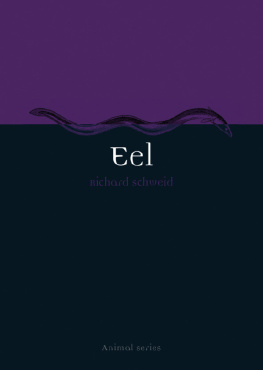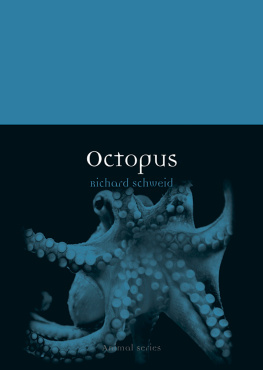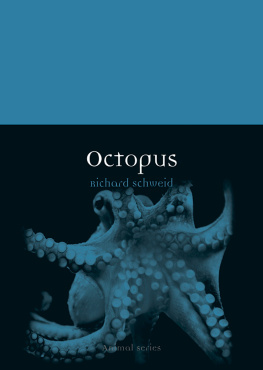Schweid - Eel
Here you can read online Schweid - Eel full text of the book (entire story) in english for free. Download pdf and epub, get meaning, cover and reviews about this ebook. City: London, year: 2009, publisher: Reaktion, genre: Romance novel. Description of the work, (preface) as well as reviews are available. Best literature library LitArk.com created for fans of good reading and offers a wide selection of genres:
Romance novel
Science fiction
Adventure
Detective
Science
History
Home and family
Prose
Art
Politics
Computer
Non-fiction
Religion
Business
Children
Humor
Choose a favorite category and find really read worthwhile books. Enjoy immersion in the world of imagination, feel the emotions of the characters or learn something new for yourself, make an fascinating discovery.
- Book:Eel
- Author:
- Publisher:Reaktion
- Genre:
- Year:2009
- City:London
- Rating:4 / 5
- Favourites:Add to favourites
- Your mark:
- 80
- 1
- 2
- 3
- 4
- 5
Eel: summary, description and annotation
We offer to read an annotation, description, summary or preface (depends on what the author of the book "Eel" wrote himself). If you haven't found the necessary information about the book — write in the comments, we will try to find it.
Eel — read online for free the complete book (whole text) full work
Below is the text of the book, divided by pages. System saving the place of the last page read, allows you to conveniently read the book "Eel" online for free, without having to search again every time where you left off. Put a bookmark, and you can go to the page where you finished reading at any time.
Font size:
Interval:
Bookmark:


Animal
Series editor: Jonathan Burt
Already published
Crow | Fox | Pig |
Ant | Fly | Pigeon |
Tortoise | Cat | Camel |
Cockroach | Peacock | Chicken |
Dog | Cow | Wolf |
Oyster | Duck | Penguin |
Bear | Shark | Ape |
Bee | Swan | Butterfly |
Rat | Rhinoceros | Sheep |
Snake | Horse | |
Falcon | Elephant | |
Whale | Moose | |
Parrot | Forthcoming | |
Tiger | Hare | |
Salmon | Spider |
Richard Schweid

REAKTION BOOKS
Published by
REAKTION BOOKS LTD
33 Great Sutton Street
London EC1V 0DX, UK
www.reaktionbooks.co.uk
First published 2009
Copyright Richard Schweid 2009
All rights reserved
No part of this publication may be reproduced, stored in a retrieval system or transmitted, in any form or by any means, electronic, mechanical, photocopying, recording or otherwise without the prior permission of the publishers.
Page references in the Photo Acknowledgements and
Index match the printed edition of this book.
Printed and bound in China
British Library Cataloguing in Publication Data
Schweid, Richard
Eel. (Animal)
1. Eels
I. Title
597.43
eISBN: 9781861897473
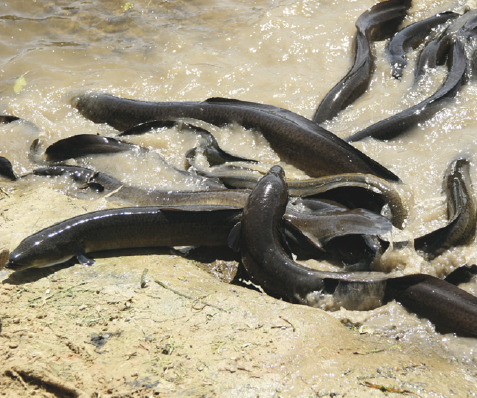
Heres to the eel.
This book is a portrait of that amazing and slippery freshwater fish found in the rivers of North America and Europe. It is an animal with a fascinating natural history, and humans have eaten it for thousands of years. It is not the infamous electric eel, which lives in the headwaters of the Orinoco and Amazon rivers, nor the moray eel, that vicious marine predator, nor one of the other more than 400 other species of eel that are known around the world. The freshwater eel is a snake-like fish, covered in slime and without sharp teeth, hunkered down at home in the muddy bottom of some slow-moving body of fresh water a river, lake, pond or creek. Surprisingly, the life cycle of this torpid, freshwater fish is one of the most astonishing on the planet, and remains one of the animal worlds great unsolved mysteries. It has challenged naturalists and biologists since Aristotle first conjectured about eel reproduction more than two thousand years ago. Chapter One examines what we do know about the eels natural history and how we know it.
All the eels in all the rivers of both North America and Europe are believed to be born in the same area of the Sargasso Sea, which is a million square miles of water within the Atlantic Ocean, between Bermuda and the Azores, bounded by strong currents. It is believed to be the only place where American and The eels average lifespan is thought to be 1015 years, but eels in captivity have lived 55 years. Freshwater eels are called yellow eels until they mature sexually and change into silver eels, in which form they return down river to the ocean, then on to the Sargasso Sea where they will spawn and die.
The survival of both species appears to be threatened. As chapter Two explains, wild stocks are in precipitous decline. The problem is not one that is immediately evident, because the grown eels that people are most likely to cross paths with are still plentiful. These are eels that entered fresh water as glass eels up to fifteen years ago. It is only in recent years that the numbers of larvae entering rivers appears to have fallen so drastically. Although no one knows why larvae choose to enter any given river, what is clear, around the world, is that many fewer are doing so. Scientists generally believe that this means that fewer larvae are hatching in the Sargasso. From the St Lawrence river in Canada to the Chesapeake Bay in Maryland and from the River Bann in Northern Ireland to the River Po and the wetlands of Comacchio on the coast of northern Italy, glass eel recruitment is decreasing year by year. Explanations for what is causing this decline are varied. Should stocks continue to fall, and aquaculture efforts continue to fail, eels could rapidly disappear.
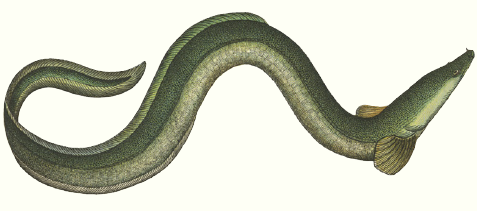
An adult eel.
and annual eel sales around the world are estimated at about $2 billion, the great bulk of which is destined for Japan.
The beginnings of the relationship between humans and eels are explored in chapter Three, from classical Greece up through the Middle Ages. The eastern Mediterranean is a long way for a larva to come from the Sargasso Sea, given the number of fish and birds that would be glad to eat it before it arrived. Still, the rivers of Egypt, Greece, and Rome all held eels and each of these civilizations accorded a different treatment to the fish.
In Western Europe people first began recording what was served and eaten, along with recipes for preparing those dishes, in the thirteenth century. The earliest cookbooks included ways to prepare eel, and it was clearly a common and much-appreciated food. The arrival of the Industrial Age did nothing to diminish peoples appetites for it. Whats more, the English colonists who arrived in the New World depended in great part on the eel to feed them. That it is an ancient food in the Americas was evident from reports of the earliest missionaries. Native Americans fished for and ate eel in a variety of ways. Chapter Four examines the history of its nutritive interaction with humans in the United Kingdom and the United States up to the twentieth century.
Chapter Five examines the way in which people have fished for eels since time immemorial. While many anglers today
Chapter Six examines the uses to which eels have been put down through the centuries (culinary ones apart), including literature, art and apparel. While eel consumption has virtually disappeared in the United States, the fish is still widely relished in Europe and the Asian market is immense. However, the natural resource is diminishing rapidly. High demand and low supply are conditions that would seem to provide a context for the development of a lucrative aquaculture. And that would be the case, if only the eel was not so finicky about where it is born, so difficult to make comfortable in artificial conditions. Despite vast expenditures of time and money, eels steadfastly refuse to reproduce viably in captivity. The only way to farm eels is to buy glass eels captured in the wild and raise them to table size.
Font size:
Interval:
Bookmark:
Similar books «Eel»
Look at similar books to Eel. We have selected literature similar in name and meaning in the hope of providing readers with more options to find new, interesting, not yet read works.
Discussion, reviews of the book Eel and just readers' own opinions. Leave your comments, write what you think about the work, its meaning or the main characters. Specify what exactly you liked and what you didn't like, and why you think so.

